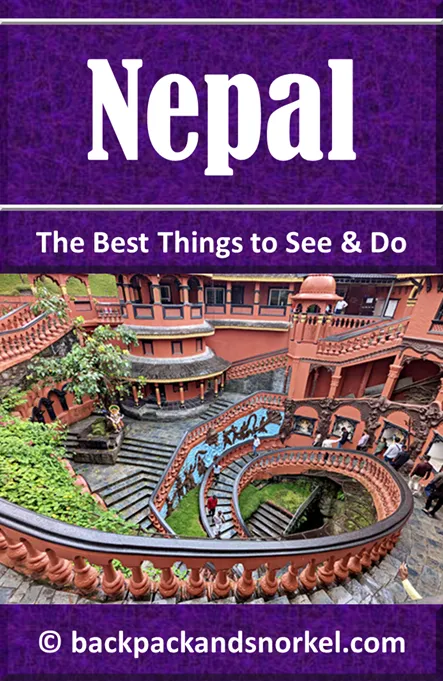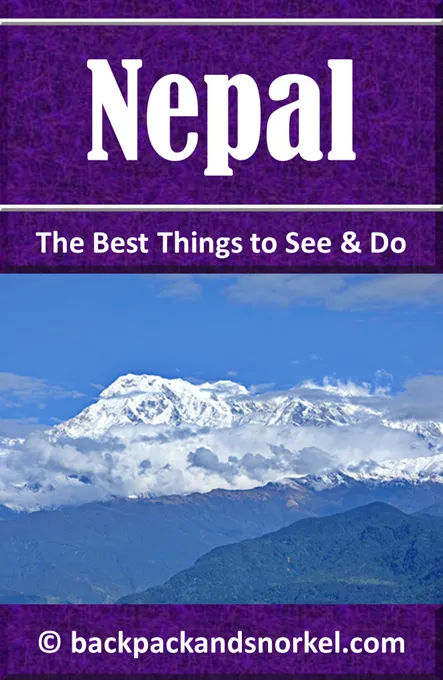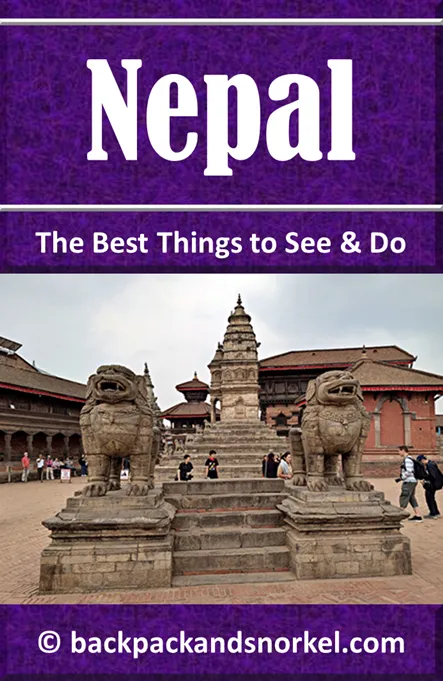Day 2 in Kathmandu: Your Self-Guided Adventure Through Thamel & Kathmandu Durbar Square - Nepal Purple Travel Guide
Today is your first full day in Kathmandu, time to start exploring the city.
Nestled in the heart of Kathmandu, Thamel is a vibrant neighborhood that has become synonymous with tourism in Nepal. A lively mix of narrow streets, colorful shops, bustling cafes, and centuries-old temples, Thamel offers a unique blend of old-world charm and modern conveniences.
Should you time your visit of Kathmandu with the Tihar festival, then make sure to do your self-guided Thamel tour on the 3rd day of Tihar (called: The Day of the Cows (Gai Tihar) or Laxmi Puja). On that day, you will see kids go from house-to-house and sing for a little money – this is a bit like Nepali Halloween, but without scary costumes and candy.
Here at Backpack and Snorkel Travel Guides, we typically promote self-guided walking tours.
But we realize that not everybody likes to walk by themselves in a foreign city. So, just in case that you rather go with ab guide: NO PROBLEM! Please see the Viator tours below.
free GuruWalk tours
paid Viator tours
Meaning of the word Thamel
The name Thamel is believed to have originated from the Newar language, historically spoken by the indigenous people of the Kathmandu Valley. While the exact etymology remains debated, it’s commonly linked to the area’s early use as a resting place for traders and travelers long before it became the bustling tourist hub it is today.
What to Expect in Thamel
Thamel has served as Kathmandu’s tourism center since the 1970s, when backpackers and mountaineers first began flocking to Nepal. Today, it remains a go-to destination for international visitors seeking adventure, culture, and convenience. Here's what makes Thamel special:
Shopping: Thamel’s streets are lined with shops selling everything from handmade pashminas and prayer flags to trekking gear and Tibetan antiques.
Cuisine: With eateries ranging from traditional Nepali restaurants to international cafés, Thamel is a haven for food lovers.
Nightlife & Music: The neighborhood comes alive in the evenings, offering live music, rooftop bars, and cultural performances.
Travel Services: Thamel is the top spot for finding tour operators, trekking guides, travel agencies, and foreign exchange services - ideal for planning your Himalayan adventure.
Self-guided walking tour of Thamel
Many of the roads we walk on today either don’t have sidewalks or only have extremely narrow and often uneven sidewalks. So, do what everybody else does – share the street with motorcycles and cars and be careful when you walk.
The following maps show the route that you will take today – there is a separate map for the self-guided walking tour of Kathmandu Durbar Square:


Ga Hiti Stone Spouts
(map, reviews)
This is Premium Content! To access it, please download our
Backpack and Snorkel Purple Travel GuideGa Hiti Stone Spouts offer a fascinating glimpse into the ingenuity and sustainable design of the Newar civilization who designed this ancient water management system. Often overlooked by tourists, this site is one of 573 Stone Spouts in the Kathmandu Valley.
Detailed information can be found at our Ga Hiti Stone Spouts Page

Bikramshila Mahaviha Temple
(map, reviews)
This is Premium Content! To access it, please download our
Backpack and Snorkel Purple Travel GuideThe name ‘Bikramshila Mahavihar’ is rooted in Sanskrit and Buddhist tradition. ‘Bikramshila’ refers to an ancient monastic university in India, once a renowned center of Buddhist learning, while ‘Mahavihar’ means ‘great monastery’. This name suggests that the temple was either inspired by. or dedicated to preserving the teachings and spirit of the original Vikramashila monastery, highlighting its importance as a spiritual and educational center.
Detailed information can be found at our Bikramshila Mahaviha Temple Page


Bhagwati Bahal Temple
(map, reviews)
This is Premium Content! To access it, please download our
Backpack and Snorkel Purple Travel GuideBhagwati Bahal Temple is also known as ‘Sankateshwor Bhagawati’ or ‘Bhagwati Mandir’.
The name ‘Sankateshwor Bhagawati’ is steeped in spiritual symbolism. ‘Sankat’ means ‘danger’ or ‘crisis’ in Sanskrit, and ‘Ishwor’ means ‘lord’ or ‘divine being’. Combined, ‘Sankateshwor’ can be understood as ‘the divine protector in times of trouble’.
‘Bhagawati’ is a powerful form of the goddess Durga, worshipped as the embodiment of feminine strength and protection.
Together, the name signifies the goddess who removes obstacles and safeguards devotees from danger.
Detailed information and more photos can be found at our Bhagwati Bahal Temple Page


Chhwasal Ajima Sthan
(map, reviews)
This is Premium Content! To access it, please download our
Backpack and Snorkel Purple Travel GuideThe name ‘Chhwasal Ajima Sthan’ can be broken down into three parts. ‘Chhwasal’ refers to the neighborhood in Kathmandu where the temple is located. ‘Ajima’ is a term used in Newar culture to describe a grandmotherly goddess, one of the many local manifestations of the divine feminine, often associated with fierce protection, wisdom, and guardianship. ‘Sthan’ means ‘place’ or ‘site’ in Sanskrit. Together, the name means ‘the sacred place of the Ajima of Chhwasal’.
Ajima goddesses are key protectors of the city, and each neighborhood traditionally has its own Ajima shrine, forming a spiritual defense network across the Kathmandu Valley.
Detailed information and more photos can be found at our Chhwasal Ajima Sthan Page


Tridevi Temple
(map, reviews)
This is Premium Content! To access it, please download our
Backpack and Snorkel Purple Travel GuideThe word ‘Tridevi’ translates to ‘three goddesses’ in Sanskrit. It refers to the female counterparts of the Hindu trinity (Trimurti):
Saraswati, goddess of wisdom and learning
Lakshmi, goddess of wealth and prosperity
Parvati, goddess of power and devotion
Together, they represent the feminine divine energy that complements and balances the male deities Brahma, Vishnu, and Shiva. The temple celebrates this divine trio, making it a rare site where all three goddesses are worshipped together.
Detailed information and more photos can be found at our Tridevi Temple Page


Tibet Book Store
(map, reviews)
This is Premium Content! To access it, please download our
Backpack and Snorkel Purple Travel GuideDo you love sending postcards or letters from your trips? If you do, Tibet Book Store is your best chance of buying stamps as post offices are notoriously difficult to find in Nepal. They do not just sell stamps, saving you precious travel time, but while you are there, explore their selection of postcards, souvenirs, and wide selection of books in English and Nepali.

Dharma Dhaatu Stupa
(map, reviews)
This is Premium Content! To access it, please download our
Backpack and Snorkel Purple Travel GuideThe name ‘Dharma Dhaatu’ comes from Sanskrit and Buddhist philosophy. ‘Dharma’ refers to the universal truth or the teachings of the Buddha, while ‘Dhaatu’ means ‘element’ or ‘realm’. Together, Dharma Dhaatu signifies ‘the realm of truth’ or ‘the sphere of ultimate reality’.
A stupa is a traditional Buddhist structure that symbolizes enlightenment and often contains sacred relics or serves as a place of meditation.
The name Dharma Dhaatu Stupa can thus be interpreted as ‘the stupa representing the realm of the Dharma’, as a symbol of spiritual insight and inner peace.
Detailed information and more photos can be found at our Dharma Dhaatu Stupa Page


Shree Ghah Chaitya
(map, reviews)
This is Premium Content! To access it, please download our
Backpack and Snorkel Purple Travel GuideThe name Shree Ghah Chaitya combines these elements:
‘Shree’ is a Sanskrit prefix denoting respect and auspiciousness.
‘Ghah’ is a local Nepali term meaning ‘house’ or ‘shrine’.
‘Chaitya’ refers to a Buddhist stupa, a domed structure that enshrines relics and represents the enlightened mind of the Buddha.
Put together, Shree Ghah Chaitya can be interpreted as ‘the revered stupa shrine’, symbolizing a sacred site of devotion and spiritual reflection.
Detailed information and more photos can be found at our Shree Ghah Chaitya Page


Ikha Narayan Temple
(map, reviews)
This is Premium Content! To access it, please download our
Backpack and Snorkel Purple Travel GuideThe name ‘Ikha Narayan’ is rooted in the Newar language and Hindu tradition.
‘Ikha’ refers to the specific neighborhood or tole where the temple is located within Kathmandu’s ancient city layout.
‘Narayan’ is one of the many names of Lord Vishnu, the preserver and protector in the Hindu trinity.
Together, Ikha Narayan refers to the Vishnu temple located in the Ikha neighborhood.
Detailed information and more photos can be found at our Ikha Narayan Temple Page


Nardevi Temple
(map, reviews)
This is Premium Content! To access it, please download our
Backpack and Snorkel Purple Travel GuideThe name ‘Nardevi’ is derived from ‘Nar’, meaning human, and ‘Devi’, meaning goddess, which together signify ‘Goddess of Mankind’ or ‘Protector of People’. Nardevi is a fierce manifestation of the goddess Durga or Kali, and worshipped for her power to ward off evil, and to ensure the safety of the community.
According to local legend, the goddess appeared in a vision, prompting the establishment of her shrine at the current site to safeguard the area from misfortune and disease. Her role as a guardian deity is deeply respected in Kathmandu’s historic quarters.
Detailed information and more photos can be found at our Nardevi Temple Page


Yetakha Baha
(map, reviews)
This is Premium Content! To access it, please download our
Backpack and Snorkel Purple Travel GuideThe name ‘Yetakha Baha’ comes from the Newar language, where ‘Yeta’ means ‘upper’ and ‘kha’ refers to a water source or fountain, while ‘baha’ denotes a monastic courtyard. The name likely refers to its elevated location near a water spout or pond, an important feature for both spiritual and practical reasons in traditional Newar settlements.
Like other bahas, Yetakha Baha was historically a center for Bajrayana Buddhist practice, meditation, and community rituals led by Newar priests known as Vajracharyas.
Over time, Yetakha Baha has lost its typical monastery layout, and now only a large stupa (reminiscent of the famous Swayambhunath Stupa) in the center of the large courtyard surrounded by residential houses, is left.
Detailed information and more photos can be found at our Yetakha Baha Page


The Self-Guided Walking Tour of Kathmandu Durbar Square can be found here.
Akash Bhairab Temple
(map, reviews)
This is Premium Content! To access it, please download our
Backpack and Snorkel Purple Travel GuideThe name ‘Akash Bhairab’ combines two Sanskrit words:
‘Akash’ means sky or ether,
‘Bhairab’ refers to a powerful form of Lord Shiva in his fierce protector form.
Akash Bhairab is often interpreted as the sky form of Bhairab, symbolizing limitless cosmic energy and divine protection from above. In the Newar tradition, he is also associated with King Yalambar, a legendary warrior-king ,and the first king of the Kirat dynasty after defeating the Abhir dynasty in the 7th or 8th century BC. He is believed to be the first king of Nepal (the Kathmandu Valley and surrounding regions).
The blue face of Akash Bhairab, adorned with a silver crown and fierce eyes, is displayed prominently during major festivals, watching over the crowds from the temple’s balcony like a divine sentinel. On regular days, his face is hidden.
Detailed information can be found at our Akash Bhairab Temple Page

Seto Machhindra Nath Temple
(map, reviews)
This is Premium Content! To access it, please download our
Backpack and Snorkel Purple Travel GuideThe name ‘Seto Machhindranath’ translates to ‘White Machhindranath’ in Nepali.
Seto means white, referring to the color of the deity’s face.
Machhindranath is derived from Matsyendranath, a revered tantric yogi and a deity worshipped by both Hindus (as an incarnation of Lord Shiva) and Buddhists (as an embodiment of Avalokiteshvara, the Bodhisattva of Compassion).
At Seto Machhindra Nath Temple, Seto Machhindranath is honored as a rain god and a compassionate protector, worshipped by people from all backgrounds for good health, prosperity, and peace.
Detailed information can be found at our Seto Machhindra Nath Temple Page


Asan Dabu Temple
(map, reviews)
This is Premium Content! To access it, please download our
Backpack and Snorkel Purple Travel GuideNestled in the vibrant, chaotic, and colorful intersection of Asan Bazaar, the Asan Dabu Temple is a spiritual anchor in one of Kathmandu’s oldest and busiest marketplaces.
Detailed information can be found at our Asan Dabu Temple Page


Asan Bazaar
(map, reviews)
This is Premium Content! To access it, please download our
Backpack and Snorkel Purple Travel GuideAsan Bazaar (also spelled Ason or Asan Tole) is The Historic Marketplace at the Heart of Kathmandu. It is one of the liveliest and most iconic destinations in Kathmandu.
Detailed information and more photos can be found at our Asan Bazaar Page


Annapurna Temple
(map, reviews)
This is Premium Content! To access it, please download our
Backpack and Snorkel Purple Travel GuideThe name ‘Annapurna’ comes from two Sanskrit words: ‘Anna’ meaning food or grain, and ‘Purna’ meaning full or complete. Annapurna is thus the goddess of nourishment, believed to provide for all who seek her blessings.
She is a benevolent aspect of Parvati, the Hindu goddess of power, energy, nourishment, harmony, love, beauty, devotion, motherhood, and fertility, and consort of Lord Shiva, and is honored across Nepal and India for her role in ensuring no one goes hungry.
In the Kathmandu context, this deity holds particular importance in Asan, a market square known for its vibrant trade in spices, grains, and produce.
Detailed information can be found at our Annapurna Temple Page

Bal Gopaleshwar
(map, reviews)
This is Premium Content! To access it, please download our
Backpack and Snorkel Purple Travel GuideNestled within the historic Rani Pokhari (Queen's Pond) in the heart of Kathmandu, the serene temple of Bal Gopaleshwar stands as a captivating testament to the city's rich cultural and religious tapestry. Often referred to locally as Yamaleshwar Mahadev, this unique shrine offers visitors a glimpse into fascinating traditions.
But why two names? The original deity enshrined here is Gopaleshwar Mahadev.
The name ‘Bal Gopaleshwar’ breaks down into three parts:
Bal: meaning ‘child’ in Sanskrit,
Gopal: a name for the young Lord Krishna, meaning ‘protector of cows’, and
Ishwar: meaning ‘God’ or ‘Lord’.
Together, Bal Gopaleshwar refers to the divine child Krishna, revered for his innocence, mischief, and purity. This form of Krishna is especially loved in Hindu tradition and often worshipped with the same tenderness as one would show a child.
Detailed information can be found at our Bal Gopaleshwar Page


Dinner at the Garden of Joy - Decheling Garden Restaurant
Decheling Garden Restaurant, or Garden of Joy, is tugged away in a quiet side street of busy Tridevi Sadak (Road). It is just a few feet away from Fairfield by Marriott Kathmandu hotel, and Magnificent Hotel.
Detailed information and more photos can be found at our Decheling Garden Restaurant Page

Where do you want to go now?
Author: Rudy at Backpack and Snorkel
Bio: Owner of Backpack and Snorkel Travel Guides. We create in-depth guides to help you plan unforgettable vacations around the world.
Other popular Purple Travel Guides you may be interested in:
Like this Backpack and Snorkel Purple Travel Guide? Pin these for later:














